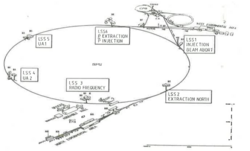 | |
| Key SppS Experiments | |
|---|---|
| UA1 | Underground Area 1 |
| UA2 | Underground Area 2 |
| UA4 | Underground Area 4 |
| UA5 | Underground Area 5 |
| SppS pre-accelerators | |
| PS | Proton Synchrotron |
| AA | Antiproton Accumulator |


UA4 experiment (COULOMB) was a high-energy physics experiment at the Proton-Antiproton Collider at CERN. The UA4 collaboration consisted of physicists from Amsterdam, Genova, Napoli, Pisa, Roma, California and CERN. UA4 was approved on 18 January 1979, and the first phase of data taking lasted until 17 June 1985. The spokesperson of UA4 was Giorgi Matthiae.
UA4 was followed by UA4/2, a collaboration between Genova, Roma, Paris, Prague, Valencia and CERN. The purpose of UA4/2 was to measure the ratio of real to the imaginary part of the forward elastic scattering amplitude. It was approved in July 1990, and recorded data throughout 1991.
The objective of the UA4 experiment was to measure the antiproton-proton cross-section, in order to show that cross-sections rising with energy are a characteristic of strong interaction. One had previously measured proton-antiproton cross-sections at the Intersecting Storage Rings, but as the Proton-Antiproton Collider — a modification of the Super Proton Synchrotron — began operating, the measurements could be done in a new energy range: up to 540 GeV center-of-mass energy.
Elastic events were detected by high resolution wire chambers and scintillation-counter hodoscopes. A system of drift chamber telescopes and counter telescopes were placed on the left and the right side of the crossing region to detect inelastic events.
After the period of data taking, the UA4 collaboration could conclude that proton-antiproton cross-section indeed rises with energy.
See also
References
- ^ "UA4/COULOMB". CERN Greybook. Retrieved 19 July 2017.
- ^ Battistion; et al. (6 October 1978). "Proposal: The Measurement of Elastic Scattering and of the Total Cross-section at the CERN proton-antiproton Collider" (PDF). SPSC. 78–105, P114. Retrieved 19 July 2017.
- ^ Augier; et al. (1997). "The UA4/2 experiment at the CERN SppbarS Collider". Nuclear Instruments and Methods in Physics Research. 389 (1997): 409–414. Bibcode:1997NIMPA.389..409A. doi:10.1016/S0168-9002(97)00330-6.
- ^ Van Swol, R. (31 August 1983). "Results from the UA4 Collaboration". 3rd International Conference on Physics in Collision. 3rd International Conference on Physics in Collision. Como, Italy: Gif-sur-Yvette: Ed. Frontières. pp. 53–65. ISBN 9782863320259.
External links
- List of publications from the UA4 and UA4/2 Collaboration
- CERN-UA-004 experiment record on INSPIRE-HEP
| European Organization for Nuclear Research (CERN) | |
|---|---|
| Large Hadron Collider (LHC) | |
| Large Electron–Positron Collider (LEP) | |
| Super Proton Synchrotron (SPS) | |
| Proton Synchrotron (PS) | |
| Linear accelerators | |
| Other accelerators | |
| ISOLDE facility | |
| Non-accelerator experiments | |
| Future projects | |
| Related articles | |